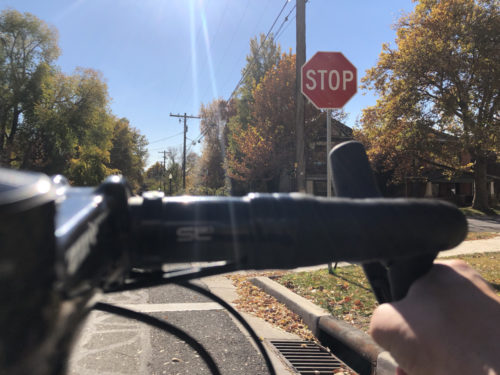Utah Bill Would Allow Cyclists to Treat Stop Signs as Yield Signs

November 7, 2018 – Utah state Representative Carol Spackman-Moss has reintroduced the Idaho Stop bill in the Utah Legislature to be considered in the 2019 Legislative Session. The bill will allow cyclists to treat stop signs as yield signs, and red lights as stop signs on roads with one lane of traffic in each direction. Representative Moss was optimistic that the bill would pass this session. In 2018, HB 58 passed the House, but failed to come to a vote in the Senate as time ran out in the session. In previous attempts in 2010 and 2011, the bill passed on branch of the Legislature but not the other. The bill would modify three sections of Utah Code: 41-6a-305, 41-6a-902, and 41-6a-1105.
In 1982, Idaho implemented a law that allows bicyclists to treat stop signs as yield signs, and stop lights as stop signs. (See: https://legislature.idaho.gov/statutesrules/idstat/title49/t49ch7/sect49-720/ ) So far, with 35 years of history behind it, cyclists are at least as safe, if not safer with the law in place. According to a 2010 paper and presentation, “bicycle injuries declined 14.5% the year after implementation” and cities in Idaho were 30.4% safer for cyclists than comparable cities without the law. (Meggs, 2010, https://meggsreport.files.wordpress.com/2011/09/idaho-law-jasonmeggs-2010version-2.pdf and https://meggsreport.files.wordpress.com/2012/07/meggs-jason-velo-city-2012-idaho-stops-law-srv2.pdf).
Utah has tried a couple of times to pass the law. The closest it came was in 2011, when it passed the house, and then failed in the senate on a tie vote. In 2010, it passed the house, but failed in the senate. More recently, Utah did pass a bill that allow cyclists and motorcyclists to proceed through a red light if the light doesn’t change within 90 seconds. This helps to remedy the issue that many stoplights are triggered by metal or weight, and cyclists and motorcyclists don’t always trigger the light to change. (41-6a-305. Traffic-control signal https://le.utah.gov/xcode/Title41/Chapter6A/41-6a-S305.html?v=C41-6a-S305_2015051220150512 )
Representative Moss said that she will be reintroducing the same version of the bill that passed the House last year.
The main part of the bill is as follows:
(5) (a) A person operating a bicycle approaching a stop sign shall slow down and, if
185 required for safety, stop before entering the intersection.
186 (b) Except as provided in Subsection (7), after slowing to a reasonable speed or
187 stopping as required by Subsection (5)(a), the person shall yield the right-of-way to any vehicle
188 or pedestrian in the intersection or approaching on another highway so closely as to constitute
189 an immediate hazard during the time the person is moving across or within the intersection or
190 junction of highways, except that a person after slowing to a reasonable speed and yielding the
191 right-of-way, if required, may cautiously make a turn or proceed through the intersection
192 without stopping.
193 (6) (a) (i) Except as provided in Subsection (6)(b), a person operating a bicycle
194 approaching a steady red traffic-control signal shall stop before entering the intersection and
195 shall yield to all other traffic and pedestrians.
196 (ii) Except as provided in Subsection (7), once the person has stopped and yielded to
197 all other traffic and pedestrians as required by Subsection (6)(a)(i), the person may cautiously:
198 (A) proceed straight through the steady red signal; or
199 (B) turn left onto a highway that is a highway with one lane in each direction.
200 (b) After slowing to a reasonable speed and yielding the right-of-way, if required, a
201 person operating a bicycle approaching a steady red traffic-control signal may cautiously make
202 a right-hand turn without stopping.
203 (7) Subsections (5)(b) and (6)(a)(ii) do not apply to an intersection Ĥ→ :
203a (a) ←Ĥ with an active
204 railroad grade crossing as defined in Section 41-6a-1005 Ĥ→ [ . ] ; or
204a (b) where any highway at the intersection has more than one lane of travel in each
204b direction, excluding turn lanes. ←Ĥ
The bill has been added to the Utah House bill list, but won’t receive a bill number until early December when this process occurs.
Representative Moss is hopeful that the bill will finally pass this year, but plans to keep reintroducing the bill until it does.
To find your legislator in the Utah Senate and House and to send in comments, see: https://le.utah.gov
In 2018, local cyclist, and Cycling West contributor John James Monroe created this video to explain the Idaho Stop, and why he thinks the law is good for cyclists and motorists:






I wish the bill success this go around. We need to ally with the media, as the misinformation about riding a bicycle on the road is just as big a hurdle as passing the law itself.Cyclist and pedestrians are the most vulnerable road users and ironically the most harshly judged if we do anything viewed as illegal, in the eyes of a not fully informed motorist. I guess I just don’t want to be targeted, even if the changed law is passed and enacted.
Comments are closed.